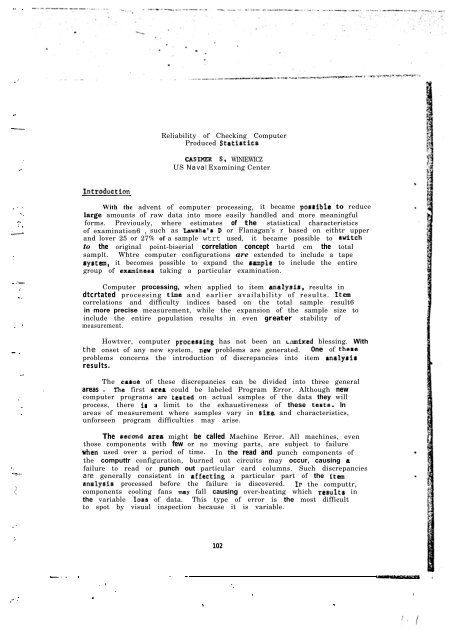Technical Report - International Military Testing Association
Technical Report - International Military Testing Association
Technical Report - International Military Testing Association
You also want an ePaper? Increase the reach of your titles
YUMPU automatically turns print PDFs into web optimized ePapers that Google loves.
*. .<br />
_-<br />
*..<br />
--<br />
_-<br />
. . .<br />
:<br />
1.<br />
.-<br />
\ .<br />
L-<br />
:<br />
_ :a.-.<br />
:<br />
-_<br />
- .<br />
-_<br />
\’<br />
._<br />
-0.<br />
-.<br />
,.<br />
---.<br />
>.<br />
*\.<br />
-.<br />
T.<br />
,-- :<br />
&ntroduction<br />
Reliability of Checking Computer<br />
Produced StatfstfcS<br />
CASMER ‘S. WINIEWICZ<br />
US Naval Examining Center<br />
With the advent of computer processing, it became porrible to reduce<br />
large amounts of raw data into more easily handled and more meaningful<br />
forms. Previously, where estimates of the statistical characteristics<br />
of examination6 , such as Iawshe’s D or Flanagan’s r based on eithtr upper<br />
and lover 25 or 27% of a sample wtrt used, it became possible to awitch<br />
to the original point-biserial correlation concept bartd cm the total<br />
samplt. Whtre computer configurations are extended to include a tape<br />
system, it becomes possible to expand the samplt to include the entire<br />
group of examineeo taking a particular examination.<br />
Computer processing, when applied to item analysir, results in<br />
dtcrtated processing time and earlier availability of results. Itan<br />
correlations and difficulty indices based on the total sample result6<br />
in more precise measurement, while the expansion of the sample size to<br />
include the entire population results in even greater stability of<br />
measurement.<br />
Howtver, computer procesring has not been an L;unixtd blessing. With<br />
the onset of any new system, new problems are generated. One of these<br />
problems concerns the introduction of discrepancies into item analyoir<br />
results.<br />
The carue of these discrepancies can be divided into three general<br />
. areas � The first arta could be labeled Program Error. Although new<br />
computer programs are &toted on actual samples of the data they will<br />
process, there is a limit to the exhaustiveness of these ttst8. In<br />
areas of measurement where samples vary in size and characteristics,<br />
unforseen program difficulties may arise.<br />
The stcond arta might be called Machine Error. All machines, even<br />
those components with few or no moving parts, are subject to failure<br />
when used over a period of time. In the read and punch components of<br />
the computtr configuration, burned out circuits may occur, causing a<br />
failure to read or punch out particular card columns. Such discrepancies<br />
are generally consistent in afftcting a particular part of the itan<br />
a.nalyais processed before the failure is discovered. Ir the computtr,<br />
components cooling fans my fall causing over-heating which reeults in<br />
the variable .loea of data. This type of error is the most difficult<br />
to spot by visual inspection because it is variable.<br />
_._ . - --<br />
.<br />
. .<br />
.<br />
3<br />
102<br />
*_<br />
.<br />
-<br />
-t<br />
.









